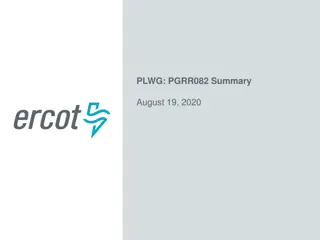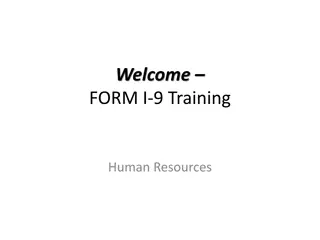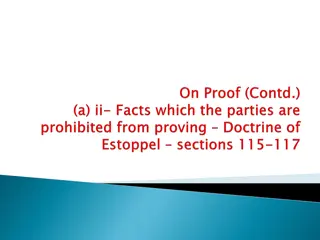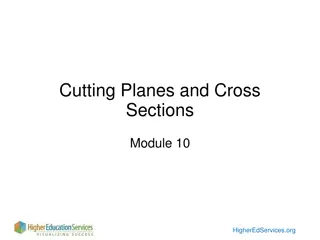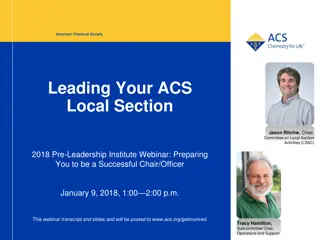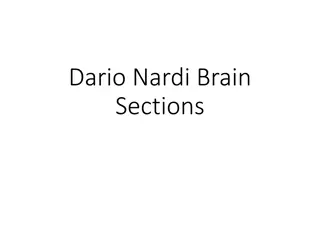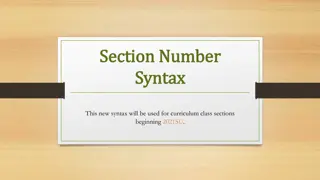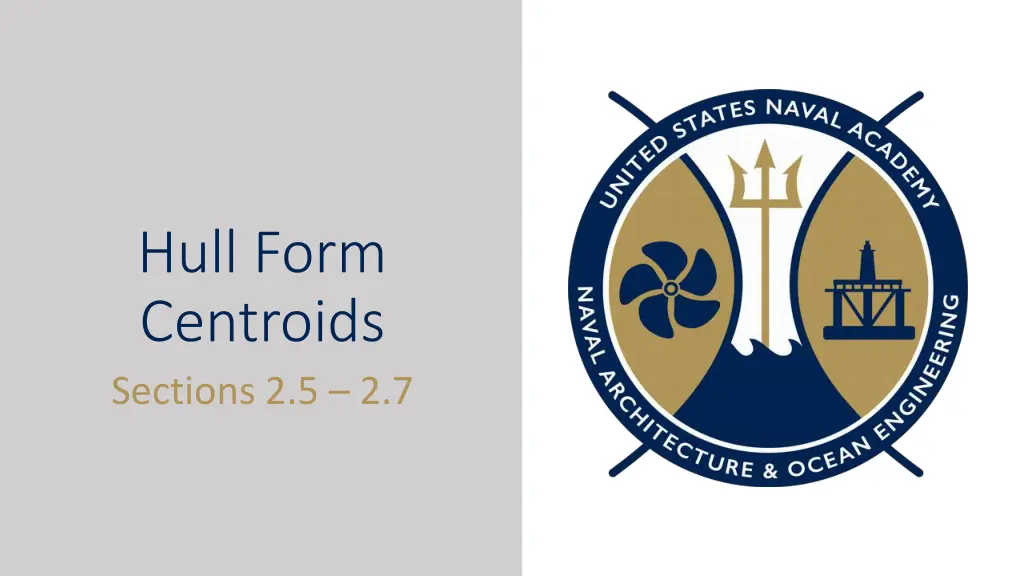
Understand Hull Form Characteristics
Explore the basic dimensions and characteristics of hull forms, including centroids, sections, and terms reviewed from the last lecture. Learn about measurements like beam, depth, draft, and more for ships. Discover the significance of flare and tumblehome in hull design.
Download Presentation

Please find below an Image/Link to download the presentation.
The content on the website is provided AS IS for your information and personal use only. It may not be sold, licensed, or shared on other websites without obtaining consent from the author. If you encounter any issues during the download, it is possible that the publisher has removed the file from their server.
You are allowed to download the files provided on this website for personal or commercial use, subject to the condition that they are used lawfully. All files are the property of their respective owners.
The content on the website is provided AS IS for your information and personal use only. It may not be sold, licensed, or shared on other websites without obtaining consent from the author.
E N D
Presentation Transcript
Hull Form Centroids Sections 2.5 2.7
Terms Review from Last Lecture FP AP DWL LOA LOA LOA(length over all) : Overall length of the vessel. Bow to Stern DWL DWL(design waterline) : Water line where the ship is designed to float FP FP(forward perpendicular) : imaginary vertical line where the bow intersects the DWL AP AP(aft perpendicular) : imaginary vertical line located at either the rudder stock or intersection of the stern with DWL Stations Stations : parallel planes from forward to aft, evenly spaced (like bread).Normally an odd number to ensure an even number of blocks.
Terms Review from Last Lecture FP AP Shear DWL Lpp Lpp Lpp ( (length between perpendiculars) : horizontal distance from FP and AP Amidships ( ) Amidships ( ) : the point midway between FP and AP Shear Shear : longitudinal curvature given to deck
Basic Dimensions and Hull Form Characteristics Beam: B WL Depth: D Draft: T View of midship section CL Depth (D): Depth (D): vertical distance measured from keel to deck taken at amidships and deck edge in case the ship is cambered on the deck. Draft (T) Draft (T) : vertical distance from keel to the water surface, wet Beam (B) Beam (B) : transverse distance across the each section, width
Basic Dimensions and Hull Form Characteristics Beam: B Camber Freeboard WL Depth: D Draft: T View of midship section Keel (K) CL Freeboard Freeboard : distance from depth to draft (reserve buoyancy), dry Keel (K) Keel (K) : the bottom of the ship Camber Camber : transverse curvature given to deck
Basic Dimensions and Hull Form Characteristics Flare Tumblehome Flare Flare: outward curvature of ship s hull surface above the waterline Wave piercing, resistance to roll, available deck space Tumblehome Tumblehome: opposite of flare Zumwalt, DDG 1000 Reduce Radar Cross Section (less mass above waterline) Sailing Yachts, Submarines
Basic Dimensions and Hull Form Characteristics
Terminology Practice R. Distance between N. & O. ___=______ _______ ______________ I. Viewed from this direction ____-_______ Plan G. Viewed from this direction ____ Plan P. Middle ref plane for longitudinal measurements _________ z S. Width of the ship ____ A.(translation) _____ C. (translation) _____ x E. (rotation) _____/____ N. Forward ref plane for longitudinal measurements _______ _____________ Q. Longitudinal ref plane for transverse measurements __________ J. _______ Line M. Horizontal ref plane for vertical measurements ________ O. Aft ref plane for longitudinal measurements ___ _____________ H. Viewed from this direction _____ Plan D. (rotation) ____/____/____ y B. (translation) ____ L. _____line F. (rotation) ___ K. _______ Line
Terminology Practice R. Distance between N. & O. LPP=Length between Perpendiculars I. Viewed from this direction Half-Breadth Plan G. Viewed from this direction Body Plan P. Middle ref plane for longitudinal measurements Amidships z S. Width of the ship Beam A.(translation) Surge C. (translation) Heave x E. (rotation) Pitch/Trim N. Forward ref plane for longitudinal measurements Forward Perpendicular Q. Longitudinal ref plane for transverse measurements Centerline Section Line J. M. Horizontal ref plane for vertical measurements Baseline O. Aft ref plane for longitudinal measurements Aft Perpendicular H. Viewed from this direction Sheer Plan y D. (rotation) Roll/List/Heel B. (translation) Sway Waterline L. F. (rotation) Yaw Buttock Line K.
Centroids Area Mass Volume Force Buoyancy (LCB or TCB) Floatation (LCF or TCF) Apply the Weighted Average Scheme or Moment =0
Centroids Centroid The geometric center of a body Center of Mass - A single point location of the mass Better known as the Center of Gravity (CG) CG and Centroids are only in the same place for uniform (homogenous) mass!!
Centroids Centroids and Center of Mass can be found by using a weighted average
Centroid of Area y x2 y3 x1 x3 y1 y2 x
Centroid of Area Example 8ft 5ft 3ft 3 4 2 7 2 2 x
Center of Floatation (F) Centroid of water plane (LCF varies depending on draft) Pivot point for list and trim of floating ship Longitudinal Center of Flotation (LCF) : centroid of water plane from the amidships ( + fwd, - aft), x-axis Transverse Center of Flotation (TCF) : centroid of water plane from the centerline, y-axis LCF Centerline TCF Amidships The Center of Flotation changes as the ship lists, trims, or changes draft because as the shape of the waterplane changes so does the location of the centroid.
Center of Buoyancy (B) Centroid of underwater portion of the ship (submerged volume) Buoyant force (FB) acts through this centroid Longitudinal Center of Buoyancy (LCB): from amidships, x- axis Transverse Center of Buoyancy (TCB) : from the centerline, y- axis Keel to Buoyancy (KB) : Vertical center of buoyancy from the Keel , z- axis TCB Centerline LCB KB Amidships
Center of Buoyancy (B) Center of Buoyancy moves when the ship lists, trims or changes draft because the shape of the submerged body has changed thus causing the centroid to move.
Centroid Definitions Center of Buoyancy (B) What is it? Centroid of the submerged volume Why is it important? Buoyant force acts through it Describe it? LCB - distance from amidships, x-axis TCB - distance from centerline, y-axis KB - distance from keel to B, z-axis Center of Floatation (F) What is it? Centroid of the waterplane Why is it important? Pivot point for list/trim Describe it? LCF - distance from amidships, x- axis TCF - distance from centerline, y- axis







